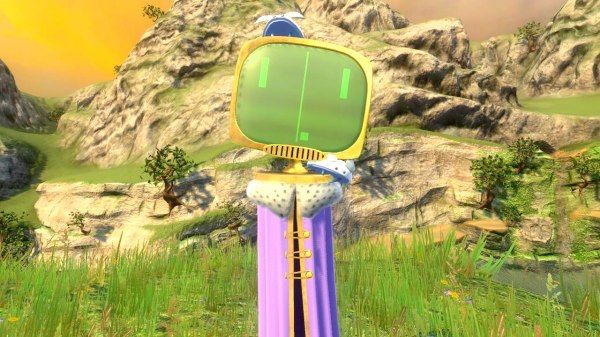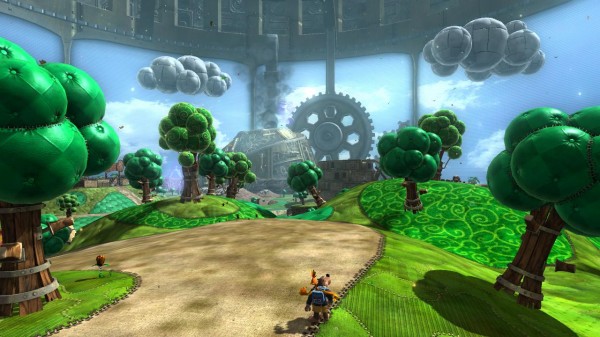
Nuts & Bolts: A Love Story
Banjo-Kazooie: Nuts & Bolts was released in November of 2008. That seems like ages ago, doesn’t it? It’s already 2013! Geez, I was in high school when the game was released, and now I am finishing college. Needless to say, a lot has changed since then, in our lives, and certainly in the world of video games. Rare is not the Rare that they used to be. And while that may make forum activity rather stale these days, the fact remains that Nuts & Bolts and Kinect Sports are really a sign of the times. They show us Rare maturing from a wild, ambitious, and experimental game developing team into a wise, business-smart, worldly team. Interpret that as you will, but whatever your view of post-Nintendo Rare, the industry around the company is really the cause of this shift in focus.
What I wish to talk about here, though, is not Rare’s new focus. It’s Banjo-Kazooie: Nuts & Bolts. You see, when describing Nuts & Bolts, there is more to analyze than software on a disc or hard drive. The odd reality of Nuts & Bolts is that there is far more at play than a single Xbox 360 title.
You all remember the trailer. A long time before Rare even released Nuts & Bolts, they released a trailer online of a new, next-gen Banjo-Kazooie game! With Jiggies! And Notes! And maybe some Honeycombs! According to that trailer, Banjo and Kazooie were coming back! On the Xbox, of all consoles!
You all remember the reactions online when info was finally released in May of 2008. Fans had mixed feelings on this sudden and unforeseen shift in genre. Understandably so, since platforming was Banjo and Kazooie’s thing. But a complete change of pace to a vehicle/racing/puzzle solving game that appealed to core gamers (those who played Banjo-Kazooie as kids) as well as casual gamers (people who just play cute party games with the family)?! We all crossed our fingers and hoped for the best. Really, though, what could go wrong?
Well, a lot of things went wrong. It’s tough to point at just one aspect of the game. Sales tanked for Banjo-Kazooie: Nuts & Bolts. Fans and critics had mixed reviews, ranging from “ruined childhoods” to “damn, this is fun!” Why the frustration? I think the answer to that lies in the game’s opening sequence.
The first bit of game play in Nuts & Bolts opens with everyone’s favorite bear and bird living in Spiral Mountain. It’s been ten years since the first game came out, and since they haven’t been on a new adventure in eight years, Banjo and Kazooie have been lazy and gained serious weight. This little sequence tells the player that the intellectual property of these characters has been underused and under-appreciated over the years.
Later, when Banjo encounters Grunty (in portable head form), their duel is interrupted by the enigmatic Lord of Games, who steps in as a sort of narrator and challenges Grunty and Banjo to a contest of who can collect the most “pointless objects” as possible (poking fun at previous Banjo-Kazooie games). When L.O.G. can’t stand to watch fat Banjo and Grunty’s skull hop around, he decids to try something else that will “broaden the demographic”. He brings you to Showdown Town and introduces the vehicle aspect of the game.

- Rare’s spokesperson for talking directly to the gamer
The symbolism of this sequence has no patience for subtlety. It’s a pretty straight-forward way of Rare telling us (through the L.O.G.) that nobody in the gaming community cares about traditional platforming anymore, and that a new change of pace for this game is what is going to happen. It’s Rare telling the gamer exactly what they’re in for. But instead of a disclaimer, Rare does this through a pithy dialogue between the main characters. You see, this is like a political cartoon! It’s using simple images and words to tell the reader/player something more complex.
And what it’s telling us core gamers is that we’re not getting the Banjo-Kazooie game we wanted. In some ways, this opening scene is a big middle finger to us core gamers. “You’re not getting what you’re expecting, so here’s something new.”
One big mistake that Nuts & Bolts makes is the blatant disregard for the series’ fanbase. “Want a Banjo-Kazooie game? Nope! Sorry!” This alienates gamers loyal to Rare and these characters. Rare wasn’t making a bad decision creatively by changing the game play drastically in a Banjo-Kazooie game (since the game play is still fun and creative), but they made a bad choice in making the game appeal and sell to the global Xbox market.
People who played Banjo-Kazooie games as children and have fond, loving memories of that excellent series of platformers are going to want that same thing; they aren’t going to care about vehicles and customization. On the other side, casual gamers (your parents, grandparents, stupid younger cousin) aren’t going to care about that bear and the red chicken when buying a game. They’re just looking for a simple, good time that doesn’t challenge them or require too much time to learn. So core gamers are ticked off now, and casual gamers couldn’t care less. Banjo-Kazooie: Nuts & Bolts, as a result, is a game that appeals to neither of its target audiences. It’s stuck in demographic limbo; Who’s supposed to like this?
I suppose people looking for unique, interesting, and creative games could like Nuts & Bolts. I mean, the visuals are stylized and great! The soundtrack is wonderful! The tongue-in-cheek humor is still here! And the game play is (in my opinion, at least) very fun and engaging! As a creative endeavor, Nuts & Bolts is successful. As a business venture for Rare and Microsoft, it’s a monumental failure.

- I have a tough time calling this a bad game.
My theory is that Rare was working on a traditional 3D platformer for Banjo-Kazooie on the Xbox 360 and a custom vehicle designing game at the same time. Then, either someone calling the shots at Rare or someone from Microsoft urged the development team(s) to merge the two games into one. This would still sell a Banjo-Kazooie game that gamers are begging for, while also ensuring the success of a new, vehicle-based game, right? No, unfortunately, you can’t just stitch two game ideas together and expect it to sell. It’s a Frankenstein’s monster of two otherwise great games that shouldn’t have been put into one.
Aside from Nintendo and Valve, I’ve always considered Rare to be one of the smartest and most keen game makers out there. How this miscommunication of game elements went unnoticed in development baffles me. But such is the state of the game industry, I suppose. Do you make a game that you know will sell even if it isn’t very new or creative? Or do you risk making an experimental and unique game that may not sell well? I have to give Rare props for trying to maintain a balance between the artistic and the practical.
What are your thoughts on this? Have a different perspective? Think I’m full of BS? Let us know with a comment in our forums!
Categories: News
0 Comments
This post has been left all alone with no comments. Don't leave it lonesome - give it some company with a comment.